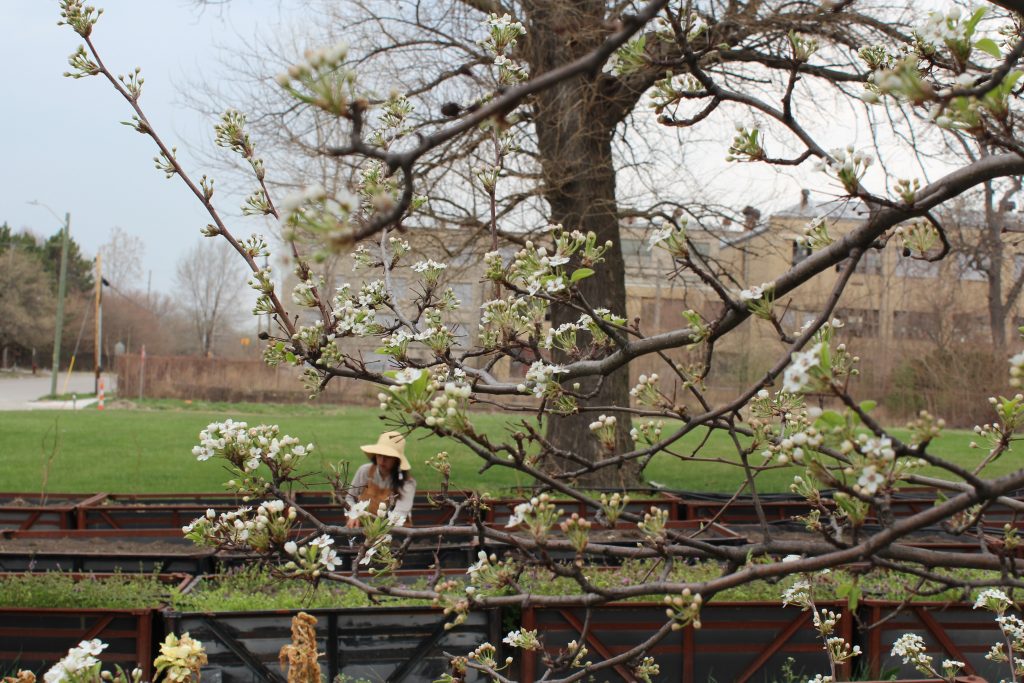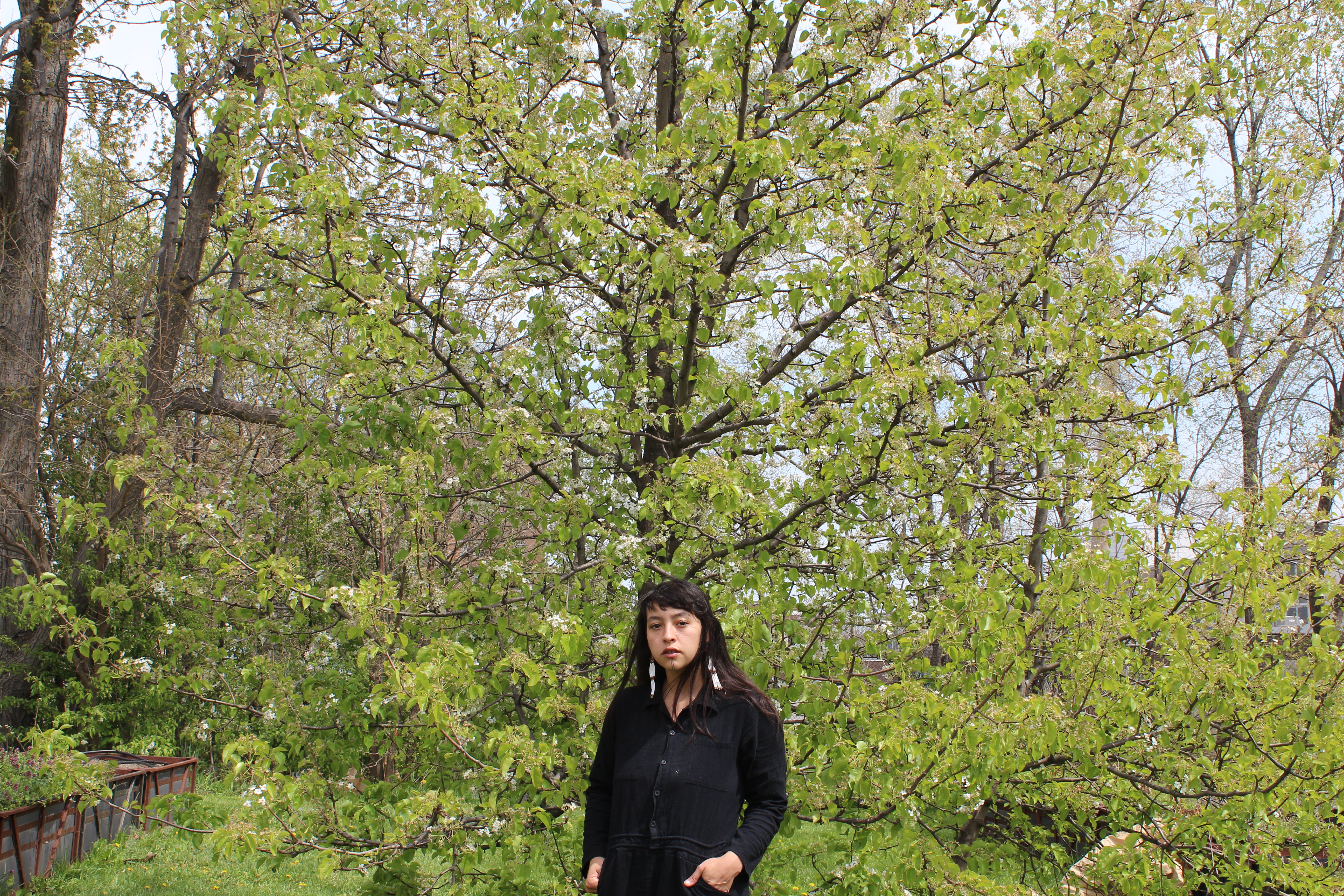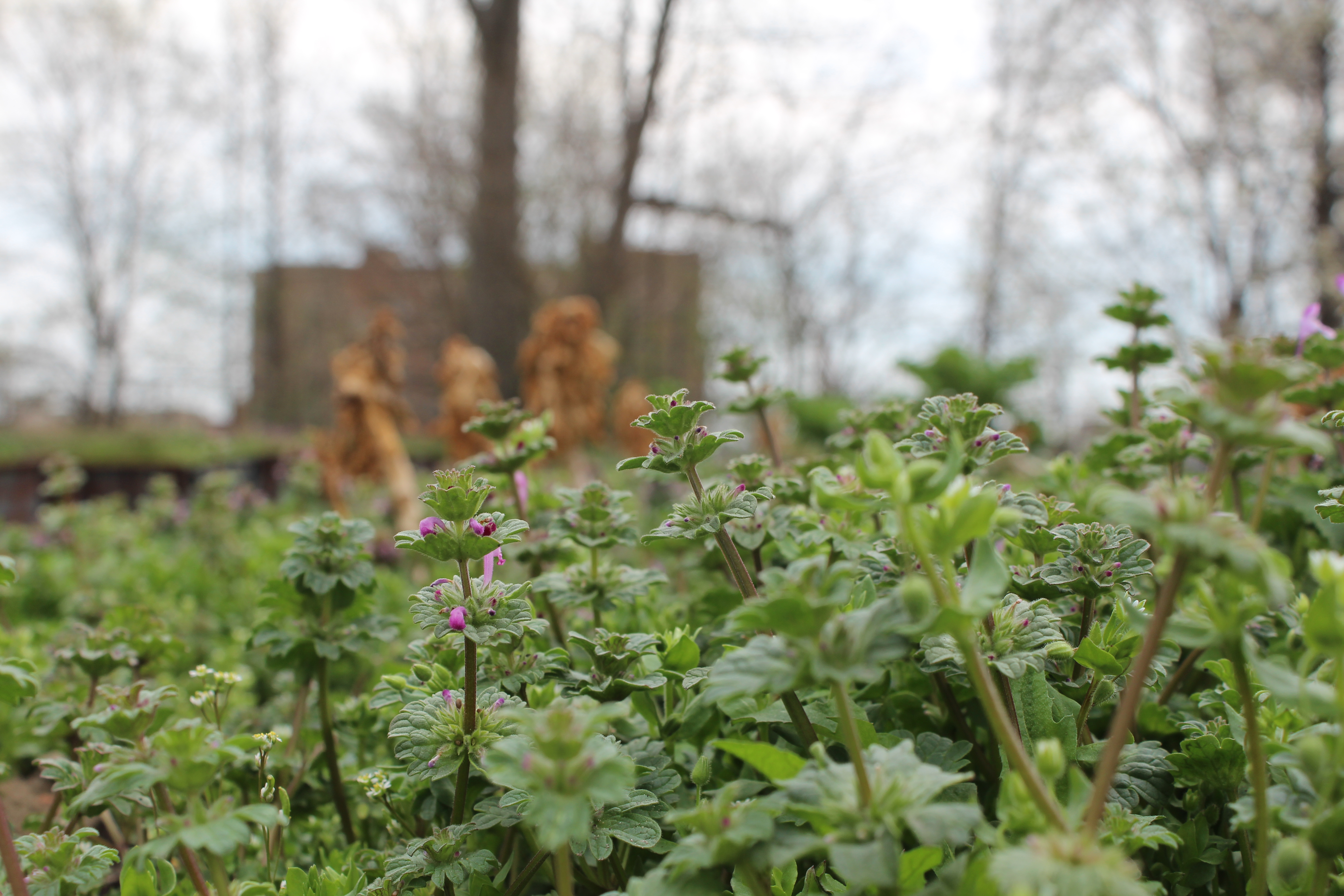Tlingit Urban Farmer Kirsten Kirby Shoote on the Power of Connecting to Ancestral Foodways
An Indigenous urban farmer, cultural food worker and seed keeper is working to develop an urban farm and Indigenous food access point in Highland Park.

Rooted shares stories about land tending, community healing and regeneration happening right here on the ancestral land of the Indigenous Anishinaabe, the area commonly referred to as Detroit.
Tlingit urban farmer, cultural food worker and seed keeper Kirsten Kirby Shoote has a new project taking shape in Highland Park. The work is just getting underway, but they’re already growing many different plants on the land there, including strawberries, raspberries, chokeberries and herbs like sage and bee balm, which is also known as wild bergamot.
Shoote starts out by explaining that this new location is just the latest iteration of their ongoing food sovereignty journey and mission. “I’ve always had a food sovereignty project in mind. And I was tending to a lot in Pontiac, and it just started as outgrowing my windowsill space … that project is called Leilú Gardens. The meaning of that word in Tlingit, which is my Indigenous language, is butterfly and it’s really about the transformative power of people and plants in our history and currently to really work together and have a relationship with each other,” they say.

Coming Into Relation With This Land
While Shoote is tending to this farm on the ancestral lands of the Anishinaabe, their ancestral lands are in what is known as Southeast Alaska. “My mother is Tlingit and I was raised in the Pacific Northwest,” they say, adding that they came to Detroit by chance. “I started off in a program apprenticing on organic farms and I sent out a bunch of emails and Detroit just happened to be the first place that got back to me,” says Shoote. But in the years since first arriving, they say they have come into close community with many Anishinaabe people living in the area who are also engaged in food sovereignty work.
Shoote admits that current state of the Highland Park lot, which they came into tending through a connection through a local neighborhood group, is pretty rough. Yet, they also note that there is so much life teeming throughout every inch of it. Their primary work here in the coming months will be working with plant relatives to remediate and rematriate the land. Shoote says they initially were growing traditional Indigenous foods, but in an effort to be culturally inclusive to other communities of color living in Detroit, they started to branch out. “I like … to be really aware of our Black relatives in the city and their food culture. Basically anything that people find useful or enjoyable or brings them back home, I will grow,” says Shoote, who has grown several different varieties of okra, along with mustards and collard greens. “These foods can be really healing. Even though I don’t have an ancestral past with them I’d like to be able to provide that for anybody who is looking for it.”
You Must Love This Planet
Otherwise, how did you get here? Sign-up to stay in the loop on all of WDET’s environmental coverage.

Seeds As Markers of Past, Present and Future Health of Community
On the role of seeds in the community as a whole, “there are so many big stories surrounding seeds in every culture; we are all tied to seeds in some way,” says Shoote, who considers themselves a seed keeper, but noting that they are in their “very sophomoric kind of phase of seed keeping.” Shoote says they “still have a very childlike wonder attached to it while also realizing the importance … of it.”
Shoote says learning about the generations of careful tending to these seeds, which is what has enabled them to be in their hands today, is a testament to the original growers and cultivators. Although this connection to ancestral foodways runs deep for Shoote these days, they say this wasn’t always the case. “Growing up, I didn’t have this connection with food; it’s something I have nurtured over the years,” says Shoote, who recognizes that not everyone has the time to access and engage with this kind of work.
“For me as an Indigenous woman, seeds are my grandmother in a lot of ways and my grandchildren in other ways. These seeds have been though tremendous amounts of trauma and the other side is that they hold so much resilience in them.” — Kirsten Kirby Shoote
“If you are working endlessly to just acquire your basic calorie intake, then you probably won’t have time to grow your own food or kind of look into your history and see what foods would nourish you on a spiritual level. That’s part of the reason I do this work is because of the inadequate food system and realizing peoples’ capacity in terms of time and money and that’s why I want to make it a free resource,” says Shoote, who is planning to get a food access point up and running by August. The food access point will live alongside the farm in Highland Park. “It will be a space where Indigenous folks around the city can come and pick up food and medicine for free or low cost to have that traditional nourishment met,” explains Shoote.

Shoote also works with an organization called the I-Collective, an autonomous group of Indigenous chefs, seed savers, artists, activists and knowledge keepers. They say the group is composed of a diverse community of Indigenous folks with a variety of backgrounds who come together with food sovereignty in mind. Much of Shoote’s work within that group is rooted in upholding Indigenous food culture and sharing the ancestral significance and narrative around these foods through events like food pop-ups for Native and non-Native audiences alike. When holding these events, Shoote says that it’s become clear that “food is such a useful vehicle for communicating something outside of words.” Noting that as soon as someone bites into a piece of bison or eats manoomin (Indigenous wild rice) for the first time, “there something within that food that speaks for itself,” says Shoote.
Looking ahead, Shoote is hopeful. “Our future as Indigenous people is more resilient than ever for me right now,” says Shoote who says they have been imagining a future “where there’s manoomin … back in unpolluted waters of the Huron and a future where there are celebrations of Indigeneity, where we will gather and be at home again.” Shoote says this ability to come home is a big part of what pushes her to keep doing this work. “The Indigenous diaspora isn’t talked about very often but we were removed from our lands and even though we still reside on the lands of our ancestors it’s in a very different shape and part of what I want for the future is to reshape our life on the land … and that’s where working with plant relatives gets me,” they say.
Terms to Know
Food sovereignty
A definition of this term that is commonly cited comes from the first global forum on food sovereignty back in 2007, which explains it as “the right of peoples to healthy and culturally appropriate food produced through ecologically sound and sustainable methods, and their right to define their own food and agriculture systems.” When talking about this idea in an indigenous context, it’s also important to note the spiritual aspect of this work and how food and land based practices are an integral piece of being in community with human, plant and animal relatives.
Seed keeping
Seed keeping is work rooted in preserving the culture, history and health of plant and food systems in communities around the world. In an indigenous framework, seeds are so much more than a food source. Seeds hold stories, they are a community historian and a cultural memory keeper. Here’s a little more context from the Native Food Alliance’s Indigenous Seed Keepers Network: “Seeds are a vibrant and vital foundation for food sovereignty, and are the basis for a sustainable, healthy agriculture. We understand that seeds are our precious collective inheritance and it is our responsibility to care for the seeds as part of our responsibility to feed and nourish ourselves and future generations”
Get Involved with Shoote’s Work
Support Shoote and other Indigenous Projects Rooted In Food Sovereignty
Check out the Go Fund Me for Shoote’s Indigenous Food Access Point
Make a Recipe Offering from Kirsten Kirby Shoote: Rosehip Sumac-ade (makes 8 8-ounce servings)
INGREDIENTS:
- ½ cup dried rosehip
- 2 cups sumac berries, sorted with leaves and sticks removed
- Maple syrup, honey or sugar to taste
- 8 cups water cool or room temperature Instructions
Step 1 Add sumac berries to a pitcher and cover with 6 cups of water
Step 2 Place a small saucepan over medium heat, add reserved 2 cups of water and ½ cup of dried rosehip. Bring to a boil, then reduce to a simmer for 5 minutes. Remove from heat and let cool completely.
Step 3 Pour rosehip water into the sumac pitcher, cover and let set at room temperature for 12-24hrs. The longer the mixture steeps, the stronger the final beverage will be.
Step 4 Once the mixture is finished steeping, strain through a fine-mesh sieve or cheesecloth into a clean pitcher. Add sweetener to taste and serve over ice.
Trusted, accurate, up-to-date
WDET is here to keep you informed on essential information, news and resources related to COVID-19.
This is a stressful, insecure time for many. So it’s more important than ever for you, our listeners and readers, who are able to donate to keep supporting WDET’s mission. Please make a gift today.
